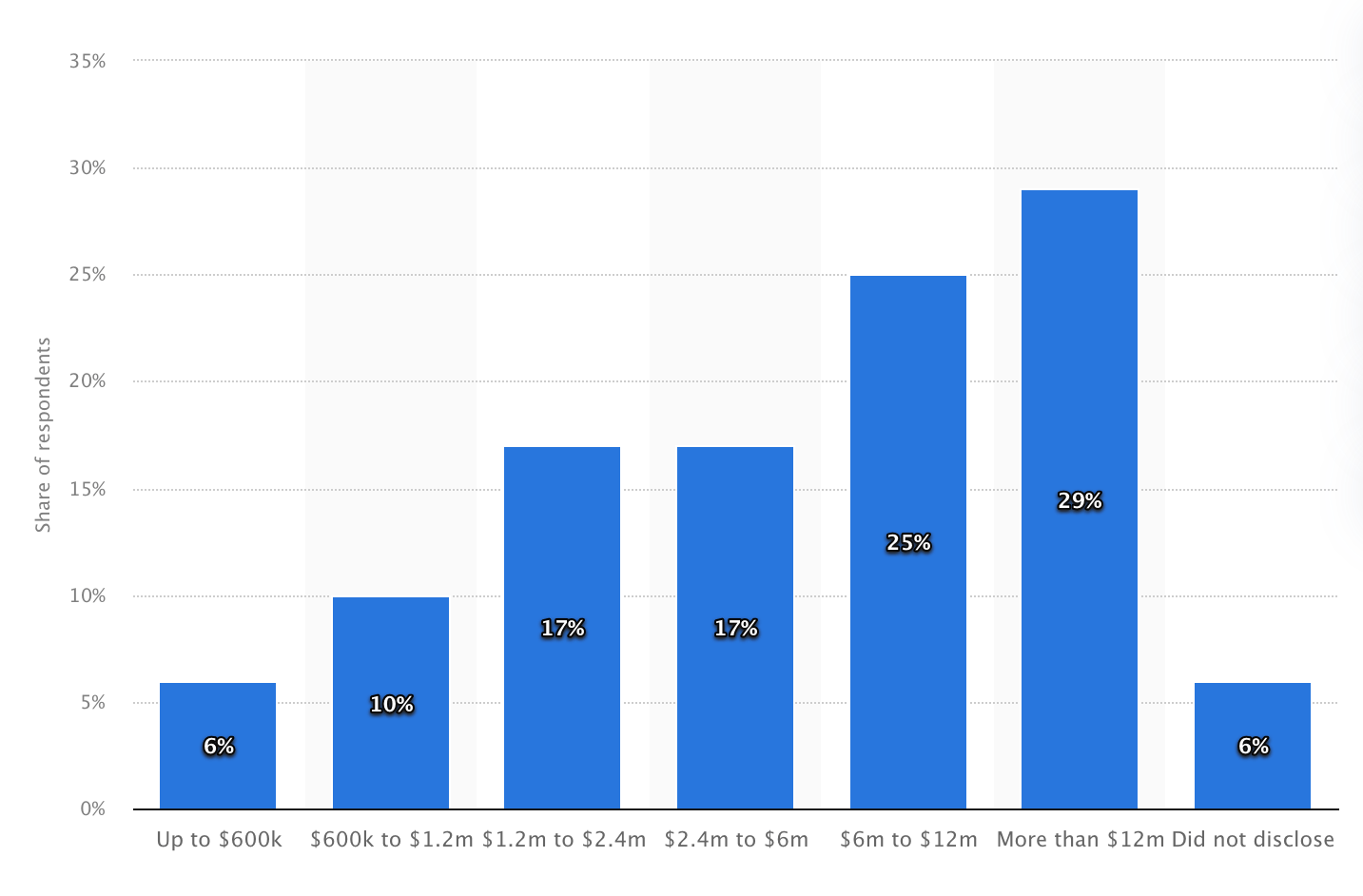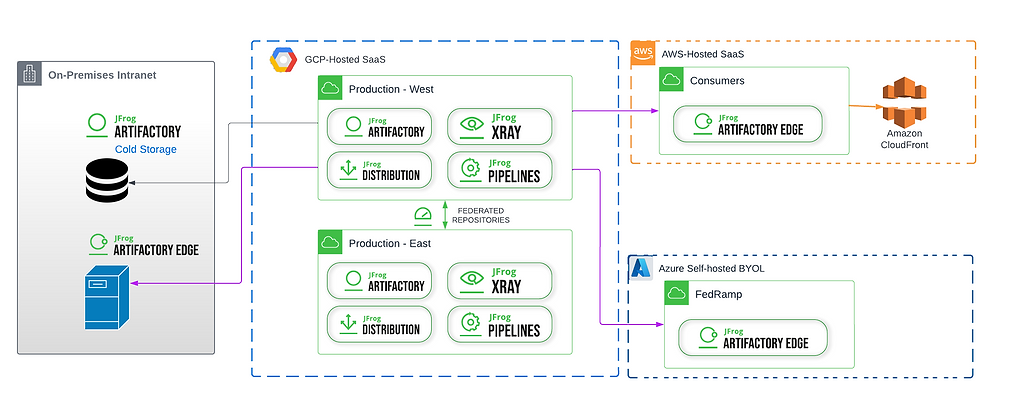SaaS or Self-Hosted, JFrog Has You Covered
Freedom of choice can make choosing harder. Since a JFrog cloud (SaaS) account provides the same functionality as a self-hosted JFrog Software Supply Chain Platform how will you decide which is right for you?
Choice without tradeoffs is one of the key ways JFrog enables you to be cloud-nimble, and run the mission-critical heart of your DevSecOps process wherever you need it to be — in any cloud, public or private, as SaaS, BYOL, or on-prem.
So how will you decide? What circumstances make a JFrog cloud account the best fit, and when do you need to manage your JFrog Platform on your own infrastructure?
Let’s look at the benefits and drawbacks of each, so you can make the best choice for you. We’ll also consider why you may want to not choose at all, and use both.
Cloud Modernization
For the modern enterprise, cloud computing is now the default model for applications, storage, and compute. As the range of providers and services expand, organizations recognize that cloud is the key to business modernization.
Many organizations find that the cloud enables them to innovate fast, and to make bold digital bets at minimum cost and risk while being able to scale elastically. The modern enterprise is now cloud-enabled, software-driven, and virtual.
In 2023, 88 percent of enterprises reported cloud spend of more than $1.2 million, including 37 percent spending $12 million and above.

Cloud transformation has accelerated with the rise of remote work, as businesses decentralize their operations. As of a 2023 study, nearly 13 percent of full-time employees work entirely from home, while about 28 percent work a hybrid model. With fewer employees to manage on-prem infrastructure, organizations are strategically shifting more workloads to the cloud.
SaaS vs Self-Hosted – What’s the Difference?
While there are no functionality tradeoffs between self-hosted and SaaS deployments of the JFrog Platform, there are benefits and limitations to each choice. Which type of JFrog account will fit you best depends on your organization’s requirements and what’s most important – or convenient – for you.
As with any infrastructure option, your choice may be driven by your degree of concerns for things like security, performance, ease of maintenance and cost.
JFrog Cloud (SaaS)
A JFrog cloud account is a service fully managed by JFrog. Unlike many SaaS offerings, JFrog empowers you to choose the cloud provider where it will be hosted (currently AWS, Google Cloud Platform, and Azure), as well as among supported cloud regions.
As a SaaS service in the cloud, you don’t have to provide any infrastructure, so no up-front capital investment costs are incurred. Your organization will be charged by usage, based on consumption (data storage and transfer), helping to keep your total cost of ownership (TCO) low. When your JFrog account is created through the cloud provider’s public marketplace, payment can be made with cloud credits in your existing cloud provider account, making procurement much easier.
There’s nothing to install – we do everything for you. You just need to sign up with the cloud provider and region of your choice and you can start using the JFrog Platform right away for a quick time-to-benefit (TTB). We’ll keep it updated for you, so you will always be using the latest version of the JFrog Platform. Additionally, you maintain the ability to customize the platform in our SaaS environment by using JFrog Workers.
JFrog Self-Hosted
Self-hosting your JFrog Platform deployment requires you to install, administer, and manage it on the infrastructure that you provide. This can either be on servers in your own on-premises datacenter, or on compute clusters in a cloud service provider (a “bring your own license,” or BYOL installation). You will be responsible for keeping your JFrog Platform up-to-date.
When you self-manage, you exchange convenience for control. You can make your own configuration choices when you install or upgrade your deployment, such as what database to use, what filestore will house your binaries, and whether you will employ advanced techniques like filestore sharding. You can choose the level of redundancy you need for high availability and implement your own backup/disaster recovery process. And you can extend Artifactory behavior – with either JFrog Workers or your own user plugins.
Some organizations may need to self-host all or part of their operations to maximize security or fulfill regulatory requirements, in order to ensure a high degree of isolation from untrusted networks such as the internet.
Side by Side
This easy-read summary of the chief differences between JFrog SaaS and self-hosted can help guide your decision:
| Type of difference | JFrog SaaS | JFrog Self-Hosted |
| Infrastructure | Provided by cloud provider (AWS, Google, Azure) | Either in cloud provider compute or on servers in your own datacenter |
| Installation | JFrog performs standard high availability installation | Install yourself with JFrog Helm charts. Choose your database and file storage. |
| Maintenance | JFrog manages provisioning and updates | Manage on your own |
| Backup and recovery | JFrog manages disaster recovery (DR) | Manage on your own |
| Logging | Audit trail and Artifactory request cloud logs.
Log streamers coming soon* |
Audit trail log, also Live logs available through plugin.
Log analytics available through extensions for multiple observability services. |
| Pricing | Variable, based on consumption (data storage and transfer) | Fixed cost per license |
| Security | Complies with the highest data privacy, security standards and practices of top-tier providers.
Security capabilities include IP allowlist, geo-location restrictions, and using the cloud provider’s private backbone. |
Control access to unprotected networks (e.g., internet) through VPC or on-premises host.
JFrog provides tools that help you comply with major data-protection industry standards and government regulations. |
| Performance | Limited to internet connection speeds. | Can co-locate on-prem with development and configure for high availability. |
| Reliability | 99.9% SLA | Manage on your own |
| Customization | Create your own Workers | Create your own Workers or leverage Artifactory user plugins*
*Workers recommended for better results |
In addition, if you choose to go the self-hosted route, and later decide SaaS is a better approach, JFrog helps make the switch.
Multi-cloud and Hybrid: The Choice to Choose Both
While the best choice between JFrog SaaS and self-hosted may be clear for part of your DevOps pipelines, a different part of your pipeline may well need the benefits of the opposite choice. Or you may just want to host your DevOps pipelines across multiple clouds.
More and more, organizations are making the choice to choose both. According to a 2023 study commissioned by Oracle Cloud Infrastructure, 98 percent of enterprises are already using or plan to use at least two cloud infrastructure providers, with 31 percent using four or more. Further, 96 percent say they are already using or plan to use at least two cloud application providers (SaaS), with 45 percent using cloud applications from five or more providers.
Hybrid cloud and multi-cloud are fast becoming the most popular IT architectures for cloud service delivery, as enterprises seek even greater agility for their virtual operations through divestment from a single cloud provider.
Example cloud nimble (multi-cloud / hybrid) topology
Because all the JFrog Platform features that enable you to interoperate between deployments for enterprise scale — including federated repositories and push/pull replication — are available for SaaS and self-hosted, you can readily segment your pipelines across different hosts while still sharing data between them. So you can maintain consistent, unified, end-to-end DevOps practices at scale even when your repositories are spread across multiple host environments.
Still need help making a decision? JFrog Solutions Engineers are here to help! Schedule a session with one of our technical experts, and let us know what you need.






